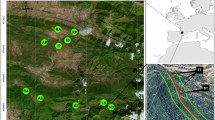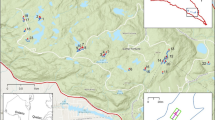Abstract
Co-variation among vegetation structural layers occurs in some forests but has been minimally found in forested wetlands. We assessed co-variation in six vegetation layers (three size classes of trees, tree seedlings, shrubs, and herbs) in 39 forested wetlands including in five before and after invasion by the beetle emerald ash borer (Agrilus planipennis; EAB) in northwestern Ohio, USA. Across the 39 wetlands, cover of wetland herbs requiring full sunlight was negatively related to tree density, while herbs tolerant of shade minimally co-varied with tree layers. Several wetlands contained both large trees and regeneration (small trees and seedlings) of the same tree species, but often distributions of large trees and regeneration were disjointed. Variation in plant community quality (e.g., non-native cover, floristic quality) for understory layers was partly modeled (34–75% of variance) using multivariate combinations of tree layers. Low-density pin oak (Quercus palustris) flatwoods, which contained species-rich, high-quality understories, drove much co-variation in vegetation layers, suggesting that coupling of layers might occur on only segments of landscape gradients. Another factor was that nearly every site had a different dominant herbaceous species, producing extreme compositional heterogeneity (94% dissimilarity among plots), limiting possible co-variation, but creating high beta diversity. On the five long-term EAB sites, shrub and herb composition co-varied before EAB invasion, but not 14 years later after shrub cover doubled. High diversity in vegetation layers among sites suggests that conserving forested wetlands, including sites that individually might not have high floristic quality, can be a major contributor to landscape diversity.




Similar content being viewed by others
References
Abella SR, Shelburne VB (2004) Ecological species groups of South Carolina’s Jocassee gorges, southern Appalachian Mountains. The Journal of the Torrey Botanical Society 131:220–231
Abella SR, Springer JD (2008) Canopy-tree influences along a soil parent material gradient in Pinus ponderosa-Quercus gambelii forests, northern Arizona. The Journal of the Torrey Botanical Society 135:26–36
Abella SR, Hausman CE, Jaeger JF, Menard KS, Schetter TA, Rocha OJ (2019) Fourteen years of swamp forest change from the onset, during, and after invasion of emerald ash borer. Biological Invasions 21:3685–3696
Andreas BK, Mack JJ, McCormac JS (2004) Floristic quality assessment index (FQAI) for vascular plants and mosses for the state of Ohio. Ohio Environmental Protection Agency, Columbus
Aronson MFJ, Hatfield CA, Hartman JM (2004) Plant community patterns of low-gradient forested floodplains in a New Jersey urban landscape. The Journal of the Torrey Botanical Society 131:232–242
Barbier S, Gosselin F, Balandier P (2008) Influence of tree species on understory vegetation diversity and mechanisms involved – a critical review for temperate and boreal forests. Forest Ecology and Management 254:1–15
Beckage B, Clark JS, Clinton BD, Haines BL (2000) A long-term study of tree seedling recruitment in southern Appalachian forests: the effects of canopy gaps and shrub understories. Canadian Journal of Forest Research 30:1617–1631
Bell DT (1997) Eighteen years of change in an Illinois streamside deciduous forest. The Journal of the Torrey Botanical Society 124:174–188
Bowles M, Jones M, Dunn C, McBride J, Bushey C, Moran R (2003) Twenty-year woody vegetation changes in northern Flatwoods and Mesic forest at Ryerson conservation area, Lake County, Illinois. Erigenia 19:31–51
Boyle MF, Abella SR, Shelburne VB (2014) An ecosystem classification approach to assessing forest change in the southern Appalachian Mountains. Forest Ecology and Management 323:85–97
Bradfield GE, Scagel A (1984) Correlations among vegetation strata and environmental variables in subalpine spruce-fir forests, southeastern British Columbia. Vegetatio 55:105–114
Breiman L, Friedman JH, Olshen RA, Stone CJ (1984) Classification and regression trees. Wadsworth, Belmont
Brewer LG, Vankat JL (2004) Description of the vegetation of the oak openings of northwestern Ohio at the time of euro-American settlement. The Ohio Journal of Science 104:76–85
Chianucci F, Minari E, Fardusi MJ, Merlini P, Cutini A, Corona P, Mason F (2016) Relationships between overstory and understory structure and diversity in semi-natural mixed floodplain forests at Bosco Fontana (Italy). iForest 9:919–926
Cho D-S, Boerner REJ (1991) Canopy disturbance patterns and regeneration of Quercus species in two Ohio old-growth forests. Vegetatio 93:9–18
Cowell CM, Hoalst-Pullen N, Jackson MT (2010) The limited role of canopy gaps in the successional dynamics of a mature mixed Quercus forest remnant. Journal of Vegetation Science 21:201–212
Davis MA, Anderson MD, Bock-Brownstein L, Staudenmaier A, Suliteanu M, Wareham A, Dosch JJ (2015) Little evidence of native and non-native species influencing one another’s abundance and distribution in the herb layer of an oak woodland. Journal of Vegetation Science 26:1005–1012
Decocq G (2002) Patterns of plant species and community diversity at different organization levels in a forested riparian landscape. Journal of Vegetation Science 13:91–106
Dollar KE, Pallardy SG, Garrett HG (1992) Composition and environment of floodplain forests of northern Missouri. Canadian Journal of Forest Research 22:1343–1350
Dunn CP, Stearns F (1987) Relationship of vegetation layers to soils in southeastern Wisconsin forested wetlands. The American Midland Naturalist 118:366–374
Ehrenfeld JG (2005) Vegetation of forested wetlands in urban and suburban landscapes in New Jersey. The Journal of the Torrey Botanical Society 132:262–279
Gagnon D, Bradfield GE (1986) Relationships among forest strata and environment in southern coastal British Columbia. Canadian Journal of Forest Research 16:1264–1271
Gilliam FS (2007) The ecological significance of the herbaceous layer in temperate forest ecosystems. BioScience 57:845–858
Gilliam FS, Roberts MR (2014) Interactions between the herbaceous layer and overstory canopy of eastern forests. In: Gilliam FS (ed) The herbaceous layer in forests of eastern North America. Oxford University Press, New York, pp 233–254
Goebel PC, Hix DM (1997) Correlations among stand ages and forest strata in mixed–oak forests of southeastern Ohio. In: Pallardy SG, Cecich RA, Garrett HG, Johnson PS (eds) Proceedings of the 11th central hardwood Forest conference. General technical report NC-188. U.S. Department of Agriculture, Forest Service, north central Forest Experiment Station, St. Paul, pp 269–282
Guyon LJ, Battaglia LL (2018) Ecological characteristics of floodplain forest reference sites in the upper Mississippi River system. Forest Ecology and Management 427:208–216
Hardin ED, Wistendahl WA (1983) The effects of floodplain trees on herbaceous vegetation patterns, microtopography and litter. Bulletin of the Torrey Botanical Club 110:23–30
Hausman CE, Jaeger JF, Rocha OJ (2010) Impacts of the emerald ash borer (EAB) eradication and tree mortality: potential for a secondary spread of invasive plant species. Biological Invasions 12:2013–2023
Host GE, Pregitzer KS (1992) Geomorphic influences on ground-flora and overstory composition in upland forests of northwestern lower Michigan. Canadian Journal of Forest Research 22:1547–1555
Johnson SE, Waller DM (2013) Influence of dam regulation on 55-year canopy shifts in riparian forests. Canadian Journal of Forest Research 43:159–170
Kaatz MR (1955) The black swamp: a study in historical geography. Annals of the American Association of Geographers 45:1–35
Klooster WS, Gandhi KJK, Long LC, Perry KI, Rice KB, Herms DA (2018) Ecological impacts of emerald ash borer in forests at the epicenter of the invasion in North America. Forests 9:250
Lyon J, Gross NM (2005) Patterns of plant diversity and plant-environmental relationships across three riparian corridors. Forest Ecology and Management 204:267–278
Mack JJ (2009) Development issues in extending plant-based IBIs to forested wetlands in the Midwestern United States. Wetlands Ecology and Management 17:117–130
McCune B, Antos JA (1981) Correlations between forest layers in the swan valley, Montana. Ecology 62:1196–1204
Menges ES, Waller DM (1983) Plant strategies in relation to elevation and light in floodplain herbs. The American Naturalist 122:454–473
Mills JE, Reinartz JA, Meyer GA, Young EB (2009) Exotic shrub invasion in an undisturbed wetland has little community-level effect over a 15-year period. Biological Invasions 11:1803–1820
Nemati N, Goetz H (1995) Relationships of overstory to understory cover variables in a ponderosa pine/Gambel oak ecosystem. Vegtatio 119:15–21
Niinemets Ü, Valladares F (2006) Tolerance to shade, drought, and waterlogging of temperate northern hemisphere trees and shrubs. Ecological Monographs 76:521–547
NRCS [Natural Resources Conservation Service] (2020) The PLANTS database. National Plant Data Team, Greensboro http://plants.usda.gov
Pabst RJ, Spies TA (1998) Distribution of herbs and shrubs in relation to landform and canopy cover in riparian forests of coastal Oregon. Canadian Journal of Botany 76:298–315
Plenzler MA, Michaels HJ (2015) Terrestrial habitat quality impacts macroinvertebrate diversity in temporary wetlands. Wetlands 35:1093–1103
Riffell S, Burton T, Murphy M (2006) Birds in depressional forested wetlands: area and habitat requirements and model uncertainty. Wetlands 26:107–118
Roberts MR, Christensen NL (1988) Vegetation variation among Mesic successional forest stands in northern lower Michigan. Canadian Journal of Botany 66:1080–1090
Sagers CL, Lyon J (1997) Gradient analysis in a riparian landscape: contrasts among forest layers. Forest Ecology and Management 96:13–26
Schetter TA, Root KV (2011) Assessing an imperiled oak savanna landscape in northwestern Ohio using Landsat data. Natural Areas Journal 31:118–130
Schuster MJ, Wragg PD, Williams LJ, Butler EE, Stefanski A, Reich PB (2020) Phenology matters: extended spring and autumn canopy cover increases biotic resistance of forests to invasion by common buckthorn (Rhamnus cathartica). Forest Ecology and Management 464:118067
Simonson WD, Allen HD, Coomes DA (2014) Overstory and topographic effects on understories: evidence for linkage from cork oak (Quercus suber) forests in southern Spain. Forest Ecology and Management 328:35–44
Stone KL, McConoughey EH, Bottrell GD, Crowner DJ (1980) Soil survey of Lucas County, Ohio. U.S. Department of Agriculture, soil conservation service. U.S. government printing office, Washington, D.C. 139 pp
Tryon CA, Easterly NW (1975) Plant communities of the Irwin prairie and adjacent wooded areas. Castanea 40:201–212
Acknowledgments
Metroparks Toledo funded this study through a contract to Natural Resource Conservation LLC. We thank Jordan Penkava, Renee Dollard, John Jaeger, and Tim Walters for help with fieldwork; Josh Brenwell for GIS support; and two anonymous reviewers for helpful comments.
Funding
Metroparks Toledo.
Author information
Authors and Affiliations
Contributions
All authors conceived and designed the research; TAS performed geographic analyses for research site identification; KSM, CEH, and SRA collected the data; SRA analyzed the data; SRA primarily wrote the paper with contributions from KSM, TAS, and CEH; all authors edited the paper.
Corresponding author
Ethics declarations
Conflicts of Interest/Competing Interests
None declared.
Ethics Approval
Not applicable.
Consent to Participate
Not applicable.
Consent for Publication
Not applicable.
Code Availability
Not applicable.
Additional information
Publisher’s Note
Springer Nature remains neutral with regard to jurisdictional claims in published maps and institutional affiliations.
Supplementary Information
ESM 1
(XLSX 36 kb)
Rights and permissions
About this article
Cite this article
Abella, S.R., Menard, K.S., Schetter, T.A. et al. Co-Variation among Vegetation Structural Layers in Forested Wetlands. Wetlands 41, 3 (2021). https://doi.org/10.1007/s13157-021-01394-w
Received:
Accepted:
Published:
DOI: https://doi.org/10.1007/s13157-021-01394-w




